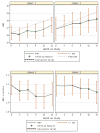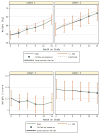Intervention in overweight children improves body mass index (BMI) and physical activity
- PMID: 23471926
- PMCID: PMC4010584
- DOI: 10.3122/jabfm.2013.02.120118
Intervention in overweight children improves body mass index (BMI) and physical activity
Abstract
Background: Childhood obesity is a growing epidemic in family medicine with few clinical treatment options. We implemented and evaluated a group office-visit intervention by family physicians for overweight children and their parents, emphasizing nutrition and physical activity within a resiliency psychosocial model.
Methods: The intervention lasted for 3 months, with half of the children crossing over to intervention after 6 months in the study. Participants included 35 children who met eligibility criteria of being in third through fifth grades and having a body mass index (BMI) above the 85th percentile. The 3-month, 12-session intervention, "Choices," included topics on nutrition, physical activity, and resiliency. The sessions were developed for delivery by a family physician and a nutritionist who received training in positive psychology and resilience skills. Main outcome measures were BMI z scores for age and sex and z scores for weight by age and sex, as well as qualitative interviews to understand individual and family processes.
Results: The intervention resulted in a significant effect on one primary outcome, BMI z score (-0.138 per 9 months [P = .017]) and a trend toward significance on the weight for age z score (-0.87 per 9 months [P = .09]). The net shift of activity from the low metabolic equivalents (METs) to the high METs had an intervention effect of 2.84 METs (P = .037). Families reported lasting changes in behaviors and attitudes.
Discussion: The innovative approach used in this study demonstrated modest efficacy in reducing BMI z score, changing physical activity levels, and possibly shifting family dynamics.
Figures



References
-
- Flegal KM, Carroll MD, Ogden CL, Curtin LR. Prevalence and trends in obesity among US adults, 1999–2008. JAMA. 2010 Jan 20;303(3):235–41. Epub 2010 Jan 13. - PubMed
-
- Ogden CL, Carroll MD. Prevalence of high body mass index in US children and adolescents, 2007–2008. JAMA. 2010;303:242–9. - PubMed
-
- Whitaker RC, Wright JA, Pepe MS, Seidel KD, Dietz WH. Predicting obesity in young adulthood from childhood and parental obesity. N Engl J Med. 1997;37(13):869–873. - PubMed
-
- Serdula MK, Ivery D, Coates RJ, Freedman DS, Williamson DF, Byers T. Do obese children become obese adults? A review of the literature. Prev Med. 1993;22:167–177. - PubMed
Publication types
MeSH terms
Grants and funding
LinkOut - more resources
Full Text Sources
Other Literature Sources
Miscellaneous
